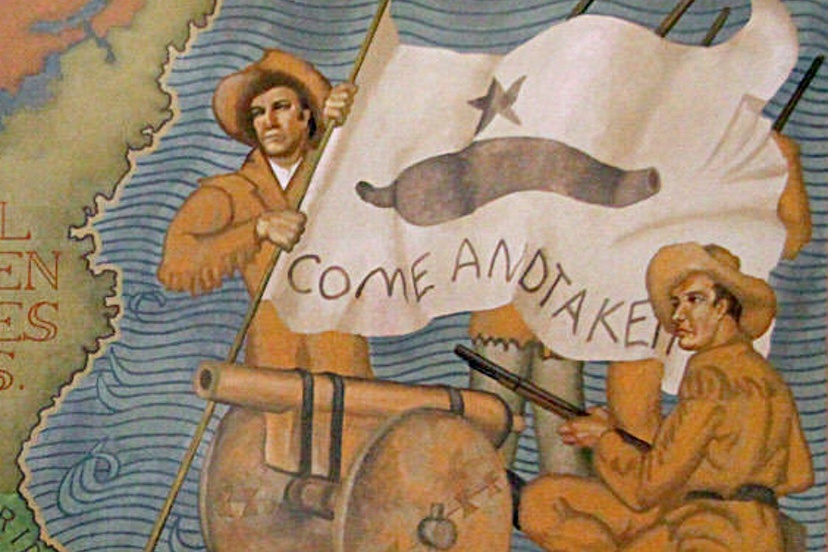Image: Detail from a museum mural in Gonzales, Texas, depicting Texas rebels who defended their cannon at the Battle of Gonzales, with their famous (or infamous) ‘Come and Take It’ flag. Note the guys hiding behind the flag.
I love how the internet connects us all together, in a big, messy soup of questionable information.
Last week — although I had no intentions of learning about the 1835 Battle of Gonzales, Texas — I fell into the internet soup and came back up, sputtering and possibly better informed about the history of Texas, and the famous (or infamous) ‘Come and Take It’ flag created by Sarah Seely DeWitt and her daughter, Evaline, from Noami DeWitt’s wedding dress.
What better use for a wedding dress! After the honeymoon, I mean.
I found the Gonzales, Texas, backstory fascinating. I don’t even care if it’s a true story, although I bet at least parts of it are true.
Apparently, Mexico had adopted a new constitution in 1824 that did a couple of things important to our story. It outlawed slavery. And it allowed foreigners to immigrate into Texas. (Foreigners being, mainly, Americans.) For some reason, the Mexican government allowed the immigrants to bring their slaves with them.
The immigrants promptly did their best to occupy Texas, but it was a big job.
One of those immigrants was Green DeWitt, who received permission in 1825 to settle 400 American families around the town of Gonzales. (I assume flagmakers Sarah Seely DeWitt and her daughter, Evaline, were related to Green DeWitt.) The local inhabitants — that is, the Karankawa, Tonkawa, and Comanche tribes — were not consulted about Mexico’s immigration policies, and they destroyed the town of Gonzales in 1826. Green DeWitt negotiated a peace treaty with the Karankawa and Tonkawa, but the Comanche continued to stage periodic raids over the next few years.
In hopes of helping the unfortunate immigrants defend themselves against the local residents, the Mexican government provided the town with a small cannon, described by historian Timothy Todish as “a small bored gun, good for little more than starting horse races”.
It seems, however, that the Mexican government did not provide any tiny cannon balls to fit the cannon, so maybe this was a political ruse to win votes?

By 1835, there were enough immigrants (and their slaves) in Texas to make the Mexican government worry about a possible revolution, and Colonel Domingo de Ugartechea, commander of all Mexican troops in Texas, sent a corporal and five enlisted men to retrieve the cannon that had been loaned to the Gonzales immigrants.
Some of the settlers believed Mexican authorities were manufacturing an excuse to attack the town and eliminate their newly-organized militia. In a town meeting, three citizens voted to hand over the gun to forestall an attack; the remainder voted to stand their ground. According to historian Stephen Hardin, “the cannon became a point of honor and an unlikely rallying symbol. Gonzales citizens had no intention of handing over the weapon at a time of growing tension.”
The Mexican soldiers were escorted from town… without the cannon.
We will remember that the immigrants did not have any cannon balls. But a point of honor is a point of honor.
When the initial request was refused, Colonel Domingo de Ugartechea sent 100 soldiers to retrieve the cannon. The soldiers neared Gonzales on September 29, 1835, but the colonists used a variety of excuses to keep them from the town, while secretly sending messengers to request assistance from nearby communities. Within two days, up to 140 armed Texans had gathered in Gonzales, all determined not to give up the cannon. On October 1, settlers voted to initiate a fight, and marched on the camping Mexican soldiers, who (naturally?) opened fire as armed immigrants approached their camp in the early morning of October 2. Two Mexican solders were killed, and one immigrant got a bloody nose. (According to the internet.)
After several hours of desultory firing, the Mexican soldiers withdrew.
The cannon had been brought to the battle, filled with miscellaneous scraps of metal, and fired once.
Apparently, once was enough.
Although the skirmish had little military significance, it marked a clear break between the immigrants and the Mexican government, and is generally considered to have been the ‘start’ of the Texas Revolution.
The town of Gonzales, Texas, holds an annual “Come and Take It” celebration during the first weekend in October. The celebration includes a classic car show, and I found this photo of a beautiful classic car that I would love to buy, if I could afford it.

(Photo courtesy Jill Robbins, Ripped Jeans and Bifocals.)
We will note, in closing, that it’s reportedly become traditional for brides in Gonzales to decorate their wedding dresses with the words, “Come and Take It.”

